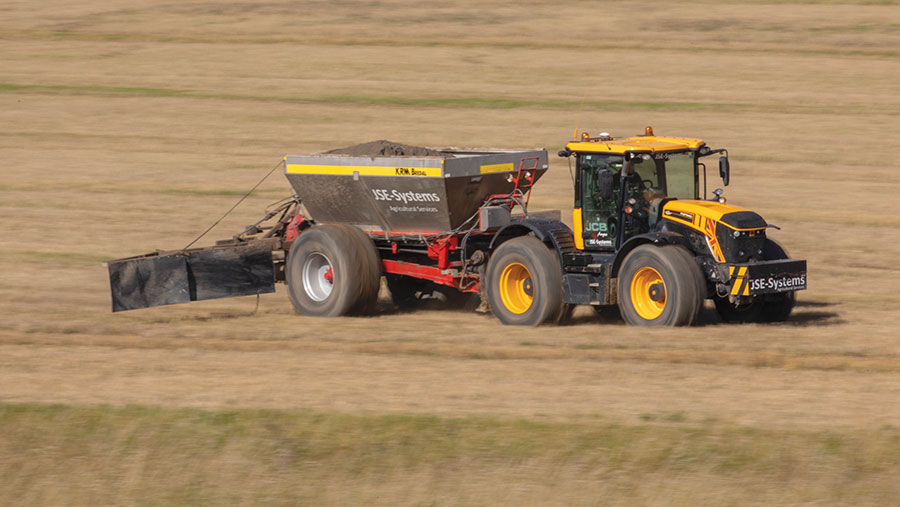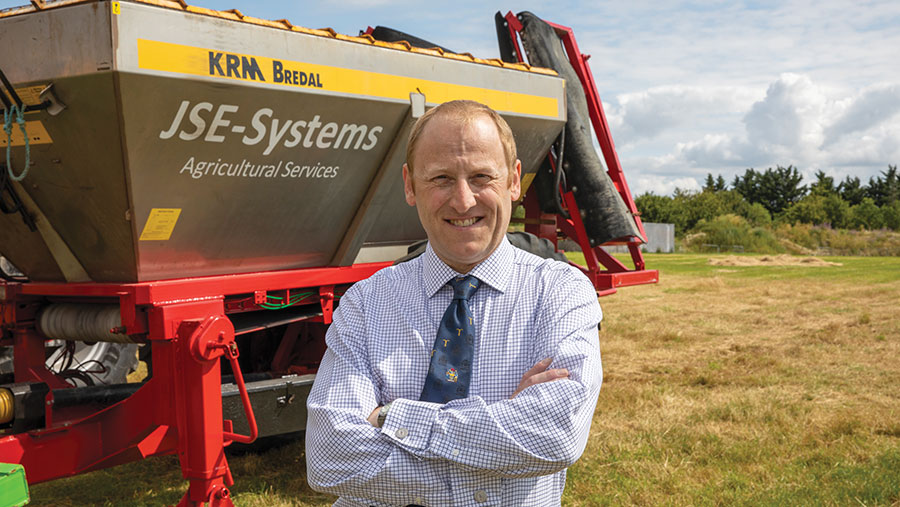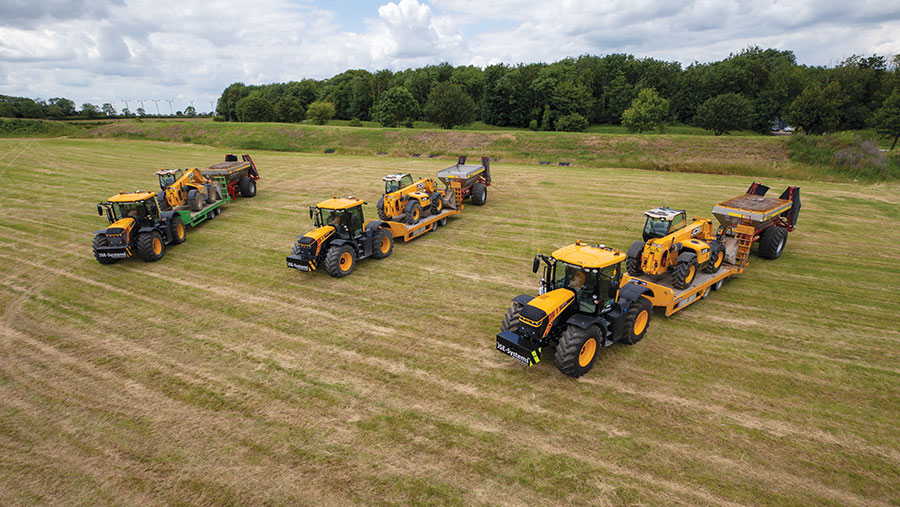Driver’s view: JSE-Systems’ high-speed spreading outfit
 © Dave Franciosy/Farming Photography
© Dave Franciosy/Farming Photography Providing a reliable and consistent application service, especially during the busiest period of an arable farm’s seasonal calendar, is a key element of JSE-Systems’ business that supplies a range of soil nutrient products.
Materials such as lime, gypsum and Fibrophos phosphate and potash fertilisers are best applied using specialist equipment that individual farms tend not to have.
But tight margins and rising machinery purchase and running costs make operating top-spec equipment for contract application an increasingly difficult challenge.
See also: Driver’s view: FSOOTY winner Matt Fuller’s Bateman RB35 sprayer
“The rate of increase in the cost of acquiring and running machinery is a very challenging trend,” says Nik Johnson, whose family-owned JSE-Systems outfit is a full-service operation supplying bulk soil nutrition materials on the back of soil sampling, analysis and advice.
“I costed up a top-spec 350hp tractor the other day and servicing alone was going to be £5/hour; that’s before depreciation, diesel, tyre wear, a man in the seat, and so on.
“New technology is a factor, of course – especially the emissions control equipment that adds several thousand pounds a time. But despite the annual price increases, we must keep investing to maintain a good service while trying to be as efficient and cost-effective as possible.”

Nik Johnson © Dave Franciosy/Farming Photography
Focus on expansion
The current business was built on the foundations of a contract service started in the 1970s by Nik’s father, Les Johnson, who set up with a single small tractor and 8t spreader.
Acquiring the Fibrophos fertiliser agency and then an Anglian Water biosolids contract helped the business expand its spreading services.
Today, JSE-Systems operates a fleet that includes seven Vredo VT4556 self-propelled spreaders with 22t bodies for Anglian Water biosolids application, and a pair of 23t, 26cu m-capacity Bunning Lowlander 230 HBD trailed spreaders for farmyard muck. These are loaded by 360deg excavators and hauled by Fastrac 8330 tractors.
Mineral fertilisers, Fibrophos, lime and gypsum are applied using four identical high-speed spreading outfits. Each comprises a 10.5t-capacity Bredal K105 spreader towed by Fastrac 4220, with a Loadall telescopic handler filling from field heaps moved from site to site on a low-loading trailer attached between the tractor and spreader.
Two similar setups are contracted in to add to the overall capacity available.
Despite the arrival of new manufacturers offering spreaders with strong credentials in terms of durability, application technology and performance, the Bredal remains Mr Johnson’s preferred choice.
“We’ve been using them for 30 years and, as my grandfather used to say: ‘If it isn’t broke, don’t fix it’. Bredal’s founder got it right from the start with a fundamentally great design.”
Buying decisions
His replacement policy is flexible and largely dependent on resale values, which fluctuate from year to year, the price of a replacement and how finances are looking generally.
“If everything looks right, we’ll replace; if not, we’ll refurbish by replacing things like the bearings, belt support rollers and the belt itself,” says Mr Johnson.
“They’re very straightforward machines and, with stainless-steel bodies, they can go on for a long time, so we might keep them for up to 10 years.”
With all four spreaders changed to new examples in the past two years, the machines now have direct hydraulic drive to the central feed belt (rather than a friction land-wheel drive) controlled through a Trimble GPS system so they can apply materials at variable rates.
“Ironically, we’re seeing less demand for variable-rate application of the products we supply, because with phosphate, for example, there is no clear evidence of what the best strategy is. If you have a field high in phosphate producing 5t/acre [12t/ha] wheat crops, will putting on more increase yields or will you restrict its potential by putting on less to save money? And if you have a low-yielding field that is low in phosphate, is that the cause or something else?
“It’s complex and takes up a lot of time trying to work out the best decision, and creating the application maps and uploading them to the spreader control invariably involves more than a couple of clicks on the computer.”

© Dave Franciosy/Farming Photography
Home-made curtains
One solution to application accuracy that definitely does work is the flexible curtain shroud fitted to each spreader, which folds out to 12m and reduces dust when spreading ash-based fertilisers, gypsum and lime products.
“That’s our ‘invention’ and it works well at getting the product on the ground to provide a more consistent and accurate application,” Mr Johnson says.
Speed and overall output are important criteria for spreading operations in the limited period between combining and cultivations, and the Fastrac tractors make a significant contribution to boost output.
“We’ve used Fastracs since the year dot, running pretty much every model that JCB has produced over the past 28 years. As an operator and owner, I’ve been impressed with JCB’s development process, because every new model has been a progressive improvement on the previous one.
“The 3230 Xtras we used to operate were good tractors, but when we tried the 4220 for the first time it was a big surprise, a real shock, to discover just how good it is, with its self-levelling suspension at the front as well as the back, the flexible CVT transmission and the more comfortable and practical cab design,” Mr Johnson says.
“The great thing about any Fastrac is that you can do 12 hours in one go and get up the next day feeling refreshed; but the 4220 has taken ride comfort to another level.”
Happy drivers
Providing operators with decent equipment is a priority that pays off for the business and keeps them in the long term, he maintains.
“Having Facts-qualified advisers and employing full-time spreader operators is imperative for consistency of service and to meet the individual needs and preferences of our customers. Our spreader operators are the interface between the business and the customer, so their knowledge of our customers’ farms – knowing where to tip, which roads to use and not to use, and so on – is essential in developing a positive long-term relationship with customers.”
The annual workload typically amounts to 40,000ha worth of supply-and-apply lime and fertiliser, as well as about 450,000t of biosolids, farmyard manure and chicken litter.
“Our business focuses on putting back the nutrients that farmers’ crops take out in a way that maintains the balance needed for all nutrients to be effective in contributing to good crop yield.
“It is well documented that nitrogen is the key driver of outright yield for most crops, but the supporting nutrients – in particular, phosphate, potash, sulphur and magnesium – are equally important in providing a fertile soil and maximum response from nitrogen.”
It follows, then, that in a year of high yields, there is strong demand for replacement nutrients and less when yields are not so good.
But the customer base is said to be sustained long term by maintaining standards that growers appreciate in terms of service quality and competitive pricing, as well as the value of using a professional spreading operation at a busy time of year.
“Our workload peaks at a time when farmers are frantic with harvest and preparations for the next crop, so we need to fit in our spreading operation by using high-capacity equipment after harvest and before cultivations get under way. A high-speed tractor and spreader combination is ideal in that respect.”

